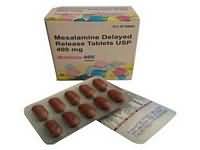CLINICAL USE
Induction and maintenance of remission in ulcerative colitis
DOSE IN NORMAL RENAL FUNCTION
Dose depends on preparation
PHARMACOKINETICS
DOSE IN RENAL IMPAIRMENT
GFR (mL/MIN)
DOSE IN PATIENTS UNDERGOING RENAL REPLACEMENT THERAPIES
IMPORTANT DRUG INTERACTIONS
Potentially hazardous interactions with other drugs
ADMINISTRATION
Reconstition
–
Route
Oral, PR
Rate of Administration
–
Comments
–
OTHER INFORMATION
Mesalazine is excreted rapidly by the kidney, mainly as its metabolite N-acetyl-5-aminosalicylic acidNephrotoxicity has been reported Mesalazine is best avoided in patients with established renal impairment, but if necessary should be used with caution, and the patient carefully monitored
